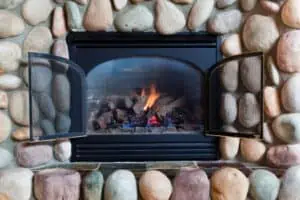How Does a Gas Fireplace Work?
Gas fireplaces are a great way to add some warmth to your home while avoiding the hassle of wood burning. They also use less fuel to create more heat, which means you’ll spend less on your monthly heating bill. Plus, a gas fireplace doesn’t need a chimney or a massive masonry hearth to function.

A gas fireplace works by converting the air in your room into combustion gases, which are then turned into heat. The process is called sealed combustion. This makes it safe to operate. In addition, gas fireplaces burn at higher temperatures for longer periods without overheating.
There are a few different types of gas fireplaces on the market, including vented, direct-vented, and ventless. However, the most common type is the direct-vented type, which connects directly to the chimney. It’s usually installed in the roof or a wall of a home.
Some gas fireplaces may have a specialized control panel. These panels are generally located below the hearth and are often hidden behind a glass or metal front. You can use the control panels to light the main burner and adjust the flame. Sometimes, the controls are manual. If so, it’s best to consult your owner’s manual for detailed instructions on how to get the most out of your new investment.
Another nifty feature of a gas fireplace is the ability to adjust the size of the flame. Most gas fireplaces have a small fitting called a burner orifice that allows a controlled amount of air to enter the flame. Changing the size of the flame can make a big difference in how much heat your home can generate.
Some gas fireplaces even have a separate dial that controls the size of the flame. While this may seem like a minor detail, adjusting the size of the flame can be a good way to save on fuel costs.
Choosing the most appropriate type of gas fireplace for your home is a crucial step. As with any electrical appliance, you need to choose one with the right features and specifications. Besides, you’ll need to find out how to properly install the device.
The biggest drawback of gas fireplaces is their reliance on natural gas. However, this can be offset by installing a venting system that enables the fireplace to vent outside. Properly venting your gas fireplace will help to keep carbon monoxide at bay. Also, it’s important to check the gaskets on the doors. Not only will this prevent the fireplace from leaking, it will also ensure your safety.
Fortunately, most modern gas fireplaces have a specialized control panel. One can even find remote controls, which can make operation of the fireplace much easier. Moreover, some models come with touchscreen panels that let you control the unit’s many functions. Of course, you’ll want to read the user manual carefully to avoid accidentally turning on the gas valve, which can cause a nasty explosion.
Other aspects of a gas fireplace include a pilot light, which is often pointed toward the main burner. A spark ignitor is used to create the spark that ignites the gas. Depending on the model, the spark ignitor may be a simple electrode or it might be a fancy electronic device.

